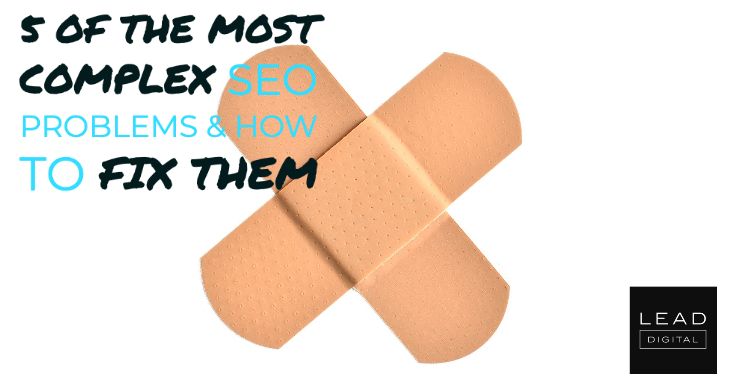 Today, running a thorough and comprehensive SEO campaign is paramount for ranking. If you aren’t optimizing your website and keeping up with the trends, then your ranking competitors surely are.
Today, running a thorough and comprehensive SEO campaign is paramount for ranking. If you aren’t optimizing your website and keeping up with the trends, then your ranking competitors surely are.
I feel that it’s useful to think about SEO as simply the amalgamation of best practices that are recognized by the search engines.
And a lot of the time the ranking of a website can be ruined by accidentally not following a best practice.
So this article is about those SEO mistakes that we all make from time to time.
If you find yourself committing those mistakes, you’ll be able to fix those, and if you haven’t yet, you’ll know to avoid them.
Problem 1: Improper Indexing of Your Pages
What it is: We all want Google to rank our pages higher. But Google’s hands can’t rank what its bots can’t see.

The best way to see if you have any indexation issues is to use Google Search Console.
In the absolute vast majority of cases, your indexation problem will be internal: perhaps the page hasn’t been allowed in your robots.txt file by a developer working on the page, or a NOINDEX tag has been added to a page.
A DNS error or a 404 error are the most likely culprits for your pages not being indexed, and Search Console will show as much in its “Error” column.
Simply removing the NOINDEX tag manually for the pages in question, or allowing them in robots.txt, and allowing some time for Google bot to recrawl in peace, will get those pages to show up without a hitch.
If you end up in a situation where the entirety of your website is patently crawlable, with index tags, but still the actual Google search gives you only a fraction of the results you expect – you might have been hit by a manual action.
Start the recovery process by running a full website-wide audit.
Using an audit tool, you’ll get a nice layout of your website’s SEO health, with all of the pages that are and aren’t indexed in there.
See what pages are violating Google’s best practices, and which simply didn’t have the correct tagging and/or robots instructions. It’s generally a good practice to check your website for crawling issues every month or so.
Problem 2: Keyword Cannibalization
A common problem stemming from the fact that some of us marketers start to “overcrowd” the same topics, publishing extremely similar materials, which more or less target the exact same keywords.
What ends up happening is that various pages compete in ranking for the same keywords. This, in turn, hurts the ranking chances of all the pages involved.
This problem is complex enough for me to write an entire article on it. This is not a casual issue, and it should be fixed as soon as possible by turning to a keyword mapping tool.
Your keyword map would look along the following lines (disclosure: this is a screencapture from Rank Tracker, a tool my team created):

With the three columns, one for the keywords you’re targeting, one for the webpages connected to those keywords, and another for general SEO information.
Sort out your website with a keyword map in hand, and make sure that all of your content is targeting a different set of keywords.
Consolidate the pages targeting similar topics, and create a single page, incorporating a number of different ones.
That way you’ll ensure that you don’t have to compete with yourself on top of everybody else creating content in your niche.
Problem 3: Wrong Page Structuring for Its Target Topic
Fact: even if you have many more backlinks than your competition, you might still be ranking lower than them.
This one might even seem counterintuitive to some, it certainly did to me when I first started handling SEO problems.
But the truth of the matter is that it’s not just about backlinks to your webpage.
Today, with all of Google’s efforts to combat quid pro quo linking strategies, simply amassing a huge backlink catalog is not enough.
Ranking higher is now, and has been for a while, not just about doing things right, but also about avoiding some punishing mistakes. It’s not only about the content, but also very much about the acceptable form.
For example, if you’re writing an article on the best footwear, and you create it as a listicle of round-about 2,000 words, and you can’t rank, you should look at your competition currently ranking.
Let’s just say that you posted a beautifully written and informative article on the best cities to live in. It’s a big piece of text with a couple of images. Names of the cities are woven throughout the text, The New Yorker-style.
Then you find out that on every page in the top-5 results for “best cities to live in” the information is presented as an image gallery with very little text. That means that Google considers this to be the best format covering that particular topic.
Simply edit your own content to fit these criteria: make it a gallery of images sporting short, clear descriptions, and see your page rise through the ranks!
And it’s a whole different conversation if we’re talking about the keywords for which Google has SERP features. What we see more and more is that Google is trying to answer users’ queries right on the SERP.
For that, it’s using such instruments as Google’s featured snippets, People also ask, Knowledge panels, and so on.
Now, getting into those is crucial, and crucially dependent on structure.
So, first, find out if it’s possible for your chosen keywords to get a SERP feature.
That’s easily done by any rank tracking software, but also by simply searching the terms you’re looking to rank for.
Go to Google’s Search Settings, and simply disable the Private results feature. Then, adjusting your region as necessary, look up your keywords.
If you see a Knowledge panel or a featured snippet in there, that means it’s on!
A huge part of getting into a SERP feature is using structured data markup.
Remember: Google’s priority is presenting its user with a quick and coherent answer to their question.
Apply structured data markup, make use of bullet points, lists, numbers, etc.
The search engine will recognize that you are providing a quick and easy answer, and will use you as a source of a featured snippet.
Adding also such structural elements as FAQ is also very helpful, as getting into any of the SERP features will increase your traffic, page views, and CTR.
It simply isn’t enough that you’ve come up with a brilliant content idea and know in your soul how to present it in the best way possible. That piece of content should also conform to what Google considers appropriate for the content.
Problem 4: Incoherent Internal Linking
We all know about setting up functional navigation.
A user has to be able to come back to homepage from anywhere, have an understanding in what section of the website they currently are, and, ideally, be able to get anywhere on the website from any page, following just the links.
But proper internal linking goes a bit deeper than that.
The reality is that we all have the “necessary”, the “core”, or, more generally, the “money” pages.
Those are the ones that we consider the pages that bring in the “real money”.
So we tend to concentrate only on them when working on our site structure instead of building large “thematic clusters” which would connect a bunch of pages together.
And, well, that isn’t exactly the best way to go about internal linking. You have to spread the wealth of links around!
Look for ways to link not just to your core pages, but from them to your smaller, “supplementary” pages.
Go back and create new links from your old content to the new.
You need to conceptualize your content as clusters of pages each supporting the other.
For example, say you have a “core” page describing your software’s feature. Put some links from it to your supplementary content about using those features in the real world, to some guides, how-to’s and guest posts as well!
And, well, if you don’t have any supplementary content – create some for your core pages, then create a nice web of internal links that would connect your website into a coherent web.
While doing this, remember to make sure to not over-optimize your anchors.
This means that you should avoid the anchors containing the keywords you’re trying to rank for, and aim for naturally suitable anchors instead (although anchors like “read here” are obviously not the best).
A nice way to improve your internal linking is to have some sort of neat visualization tool, like the one presented in Website Auditor (disclaimer: my tool), with all of your pages shown as a web of connections.
That way, you immediately see where you have the most important “nodes”, and which pages could use a little more linking. – Read more



